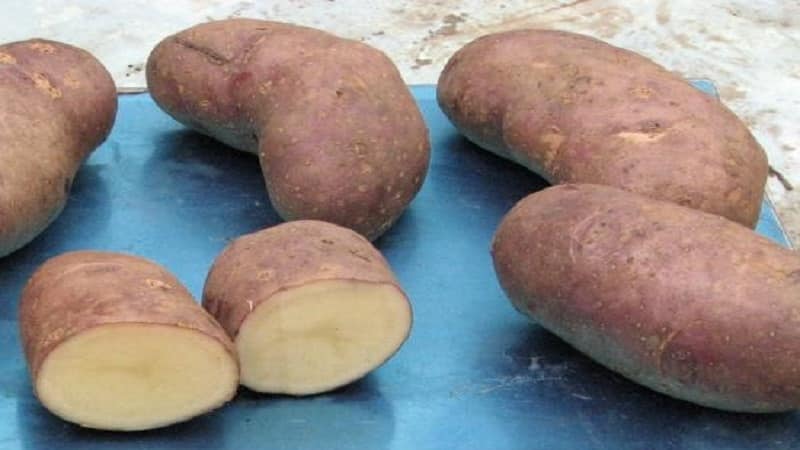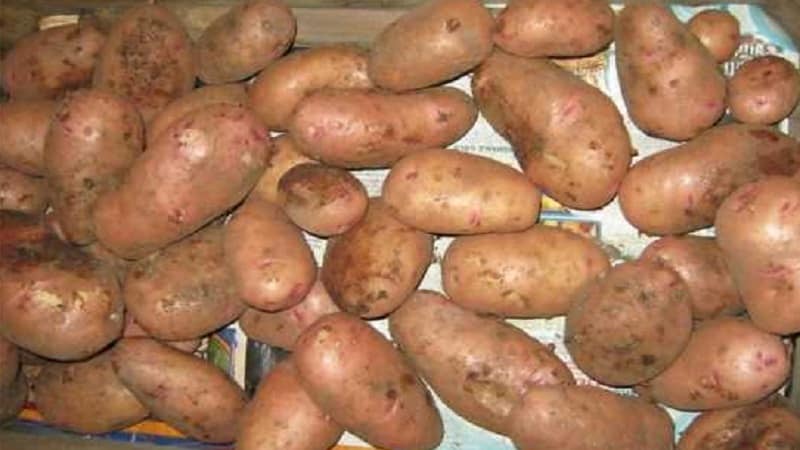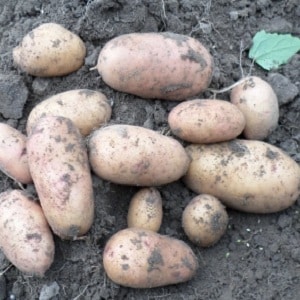Early table potato variety "Tiras" of Ukrainian selection
Potatoes are a source of ascorbic acid, vitamins B1, B, beta-carotene, phosphorus and other microelements. Nutritionists strongly recommend including it in your diet without fear of extra pounds: with moderate and balanced consumption they will not appear.
Among the whole variety of varieties and hybrids, a variety from Ukrainian breeders called Tiras takes pride of place. The culture surprises with its high productivity and large tubers, suitable for growing for sale and for personal consumption.
Description of the variety and history of origin
Tiras - Ukrainian table variety of early ripening potatoes. It was bred by biologists of the Polesie Experimental Station named after. Zasukhin "Institute of Potato Growing of NAAN" in the early 2000s.
The culture is characterized by resistance to drought and is suitable for cultivation in all regions of Russia, on any type of soil. If you follow the rules of agricultural technology in the southern regions, it produces two harvests per season.
A distinctive feature of the variety is the rapid formation of tubers with an even, almost ideal shape.

Plant and harvest characteristics are presented in the table.
| Indicators | Characteristic |
| Ripening period | 70-80 days (from germination to technical ripeness) |
| Bush | Medium height, abundantly leafy |
| Number of tubers in a bush | 9–13 |
| Weight | 115–170 g |
| Form | Oval-elongated |
| Coloring | The peel is pink, with numerous shallow eyes, the flesh is white |
| Leaves | Elongated, emerald green, with jagged edges |
| Corolla color | Red-violet |
| Starch content | 14-16 % |
| Taste | Excellent (4 out of 5 on a five-point system) |
| Cooking class/group | C (highly boiling) |
| Productivity | 210-460 c/ha |
| Marketability | 95% |
| Keeping quality | 93% |
| Purpose | Dining room |
| Sustainability | The variety is moderately resistant to leaf blight, has increased resistance to scab and immunity to cancer, nematode, leaf curl and mosaic virus. |
| Transportability | High |
Advice. To determine the culinary type of a product, cut a potato in half and rub the slices together. If droplets of water appear on the surface, then you have type A, if the halves stick together - type C or D (with a high starch content).
How to grow potatoes on the plot
The culture is absolutely undemanding to the type of soil and grows in many regions of Russia - even in areas poor in nutritional components. Potatoes perform well in regions with hot and dry climates.
The variety's agricultural technology is simple, it does not require a special approach, but to harvest an excellent quality harvest, it is recommended to adhere to certain rules. Care involves moderate watering, loosening, hilling and weeding of beds, fertilizing and preventive treatments against pests and diseases.
Dates, scheme and rules of planting
Seed material for planting is prepared in the fall. Select medium-sized tubers, without damage or signs of rotting. In the spring, the seeds are re-sorted and taken out of the basement into a bright room with an air temperature of +14-15°C, laid out on a flat surface for germination. The procedure is carried out 20-25 days before planting. During this period, sprouts will appear on the tubers.
To prevent the development of infectious diseases, seeds are disinfected in a pink solution of potassium permanganate, Fitosporin or copper sulfate.
Before planting, the area is sown with wheat, lupine, rye, flax, mustard, and a month later it is mowed and buried in the ground. Green manure plants replenish nutritional deficiencies and prevent the growth of fungi and bacteria.
Planting is carried out in early May in soil warmed to a temperature of at least +6°C. Pits are formed on the site with a depth of 8-10 cm, with an interval of 30-35 cm. 150-200 g of ash and 30 g of superphosphate are poured into each. Row spacing is 65-70 cm. Large tubers are cut into two parts, treating the cut with ash.
This is interesting:
Do potatoes cause gas and why does it make your stomach swell?
Care

Basic agricultural techniques are as follows:
- Maintaining crop rotation. It is not recommended to grow the crop for several years in a row in one place. It is optimal to use beds where cabbage, beans, and peas previously grew and not to plant potatoes next to tomatoes due to common diseases and pests.
- Moderate watering. The best way to control moisture levels is to install a drip system. When watering manually, weather conditions are taken into account: at moderate air temperatures, once a week is enough; during periods of drought, the frequency is increased to 2-3 times. It is important not to overwater the bushes, otherwise the tubers will be too watery and lose their taste.
- Loosening. The procedure is carried out after each watering, preventing the formation of a hard earthen crust.
- Hilling. An important rule for caring for potatoes, which allows you to simultaneously remove weeds and saturate the root system with oxygen.The bushes are earthed up for the first time 2-3 weeks after planting, and again after flowering.
- Harrowing. The procedure is carried out on areas exceeding three hundred square meters. A harrow is mounted on a tractor or walk-behind tractor, the teeth of which pull weeds out of the soil and deeply loosen the soil.
- Fertilizer. The Tiras variety is not too undemanding in terms of soil composition, but at the same time responds positively to organic and mineral fertilizing, increasing productivity. Before planting, a solution of chicken manure is added to the soil (1 tablespoon of dry chicken manure per 10 liters of water); after flowering, the bushes are treated with foliar fertilizers (2 g of sodium humate per 10 liters, 200 g of urea, 10 g of boric acid per 10 liters) .
Reference. Potatoes have one peculiarity - they absorb only 50% of the substances from root fertilizers and actively absorb minerals when spraying greens.
Nuances of cultivation and possible difficulties
Difficulties when growing Tiras potatoes rarely arise even for beginners. To increase productivity and protect tubers from degeneration, which is typical for many crops propagated by vegetation, experienced farmers recommend purchasing seeds from trusted sellers and promptly replacing the material.
The variety shows the same productivity both with traditional growing technology and with proprietary cultivation methods.
Igor Lyadov’s method involves planting tubers in closed beds and saves a lot of time and effort on care. Boxes with earth are installed on the site in the direction from north to south. Wooden sticks, boards, and bricks are used for production. The height of the sides is 20 cm, width - 1.1 m. The bottom is lined with straw, grass, hay, dry leaves, cardboard or paper. Compost mixed with soil is placed on top.
Before planting, the soil is loosened, holes are formed in two rows 10-15 cm deep and with an interval of 30-40 cm. Next, holes are made at a distance of 0.3-0.4 m. The tubers are planted in a checkerboard pattern, sprinkled with ash and crushed eggshells on top and covered with soil. After the bushes appear, they are weeded and the beds are mulched with straw. Further care does not differ from traditional care.
Diseases and pests
The crop is characterized by average resistance to late blight of tops and tubers, and is immune to common scab, cancer, nematode and leaf curl virus.
Symptoms of late blight:
- dark and curled leaves;
- white coating on the reverse side;
- dark spots on potatoes.
Preventive measures:
- crop rotation;
- maintaining gaps between bushes;
- selection of a site on the south side;
- soaking tubers with “Immunocytophyte” before planting;
- harvesting potatoes in dry and sunny weather;
- fertilizing with potassium and phosphorus;
- soil nitrogen control;
- treatment of bushes with a 1% solution of Bordeaux mixture, copper sulfate (20 g/10 l), Silk or Krezacin.
Treatment:
- before flowering - treatment with Ridomil Gold MC, Oxyx (twice every 10 days);
- after flowering - treatment with Bravo every 10 days;
- before harvesting - a single spraying with the drug "Alyufit".
The following methods are effective against the Colorado potato beetle:
- Treatment with birch ash in the morning on leaves damp from dew or rain (10 kg per 100 sq. m). Larvae and adults die after 48 hours.
- Infusion of white acacia bark. Pour 1 kg of dry raw material into 10 liters of water, leave for 3-4 days, strain and process the bushes.
- Celandine. Fill a 10 liter bucket halfway with fresh herbs, add water and place on low heat.Boil for 20 minutes, cool and dilute with water 1:20.
- Dandelion. 200 g of dandelion greens along with flowers, 200 g of horsetail, pour 10 liters of water, boil for 20 minutes, cool and dilute with water in a ratio of 1:5.
Collection, storage and use of crops
The first digging is carried out after 40 days. When planted in early May, young potatoes are harvested in the first ten days of June.
Potatoes are dug in dry, sunny weather, sorted, and laid out in a dark room for 3-4 days to dry. Then the tubers are distributed into wooden boxes or bags and stored in a cool place. The harvest is stored with beets, laying them on top. It absorbs moisture, preventing rotting.

In a city apartment, a balcony or loggia with glazing is used for storage. Potatoes are placed in double boxes, inserted into each other like a nesting doll. The bottom drawer should be larger in diameter. The space is filled with foam plastic or sawdust.
There are balcony storage boxes on sale, similar to large backpacks.. They can hold 1-3 bags of potatoes, and can withstand air temperatures down to -40°C. They operate from the mains, consuming 120 to 240 W.
The tubers are periodically sorted, completely taken out of bags and boxes. Rotten ones with green skin and damage are thrown away.
Tiras potatoes are more suitable for making mashed potatoes. Due to the high starch content (14-16%), the fruits quickly boil in water. To prepare salads, it is preferable to steam potatoes. According to consumer reviews, the product quickly falls apart during frying.
Advantages and disadvantages
Advantages:
- attractive presentation;
- keeping quality;
- possibility of transportation over long distances;
- amicable maturation;
- the ability to harvest twice a season;
- excellent taste;
- disease resistance;
- high productivity;
- large-fruited.
Disadvantage: Potatoes boil quickly in water, so they are not suitable for making soups and stews.
Farmer reviews
Reviews about the Tiras variety are mostly positive, but there are also negative ones from those who did not like the taste and limited use in cooking.
Alexander, Rossosh: “Tiras is a wonderful productive variety of Ukrainian selection. The tubers sometimes reach such a size that they resemble small melons. From one bush it is possible to collect about 12 pink tubers. The skin is smooth, with small eyes. The plants bloom with beautiful red-violet flowers. Buyers first of all pay attention to these potatoes, and the goods sell out in the shortest possible time.”
Inna, Roslavl: “I heard so many laudatory odes about this variety, so I decided to plant several bushes in the country. Yes, its yield is high, the tubers are large, even, beautiful, and can be stored for a long time. But I didn’t like the taste at all, especially since the potatoes boil quickly and are only good for mashed potatoes.”
Pavel, Lgov: “I’ve been growing Tiras for sale for a long time and I don’t know any grief. The result is the same from year to year, but this is subject to timely replacement of seeds. The pulp is white with a high starch content and excellent taste. The tubers are stored in the cellar until the next season, they do not rot or sprout.”
Read also:
Mid-early table potato variety "Romano" from Dutch breeders.
A unique looking and excellent tasting potato variety, Picasso from Holland.
Conclusion
Tiras potatoes are considered one of the best table varieties for growing on an industrial scale.The culture is characterized by unpretentiousness to growing conditions and soil composition, resistance to disease and ease of care. Even when cultivated on poor soils, it is possible to obtain a rich harvest.
The high starch content (14-16%) allows you to prepare a tasty, fluffy puree from the tubers, but the product is not suitable for frying, stewing and boiling. Potatoes overwinter in a cool place until the next season with minimal losses.